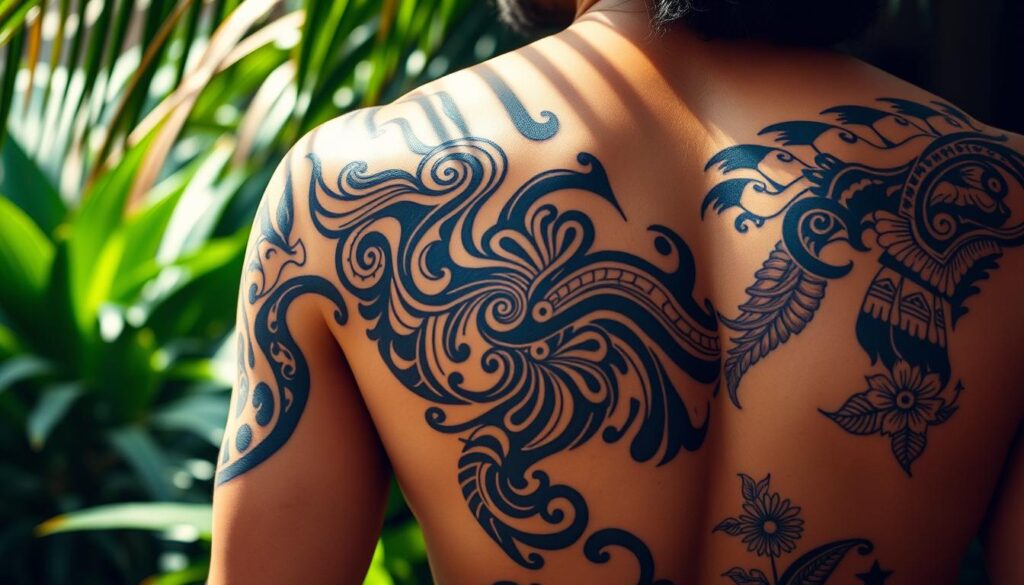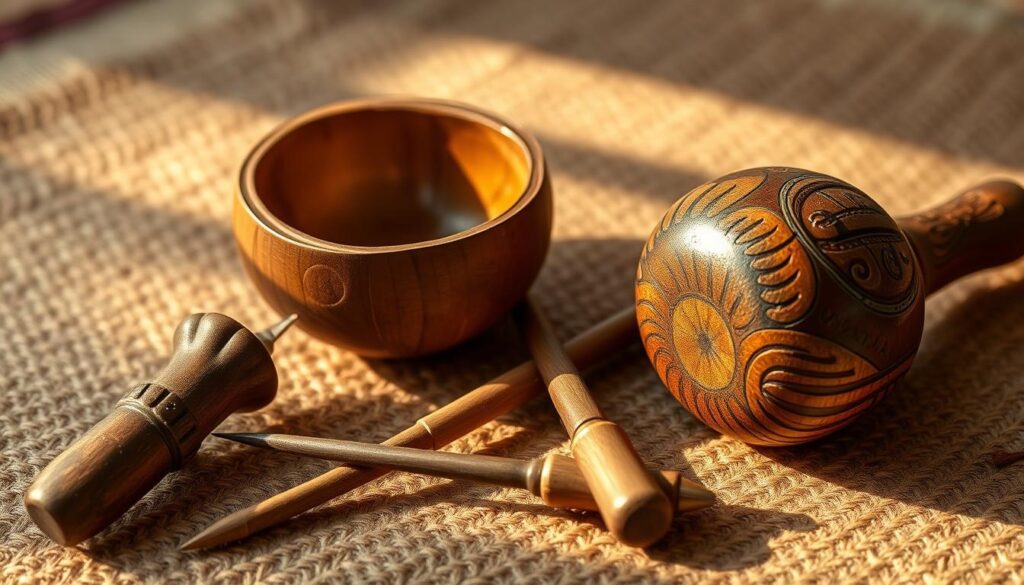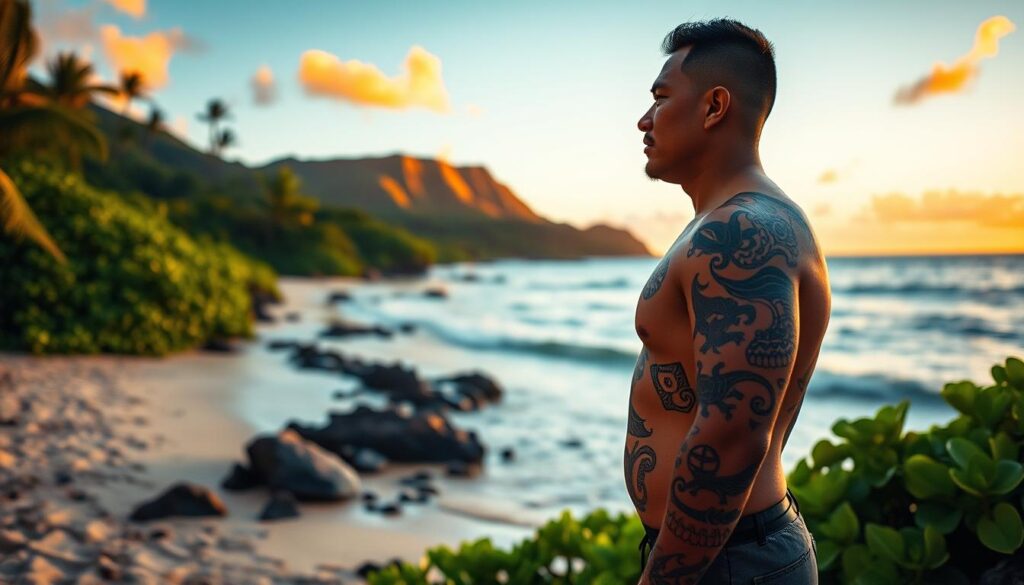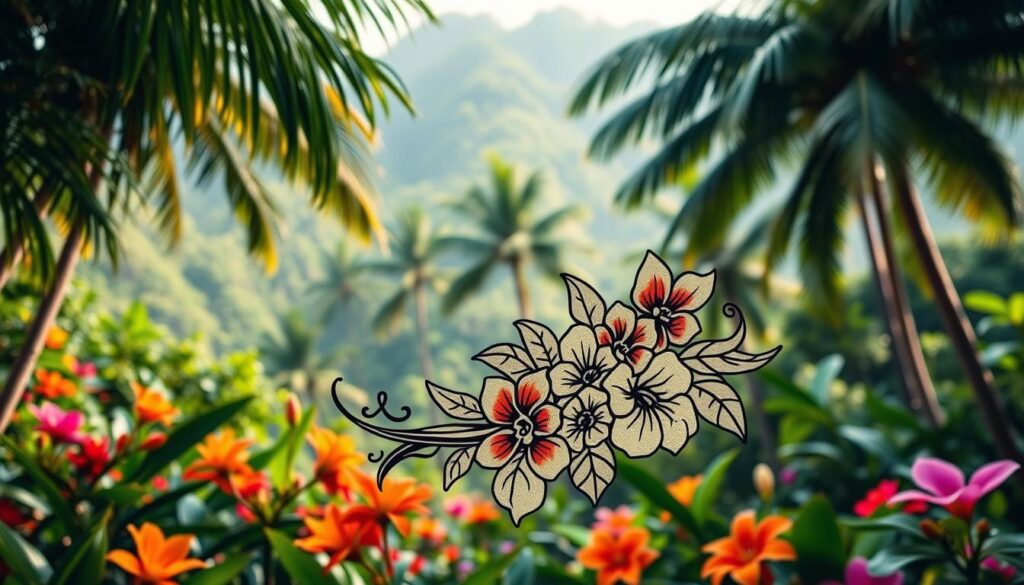
In the rich cultural heritage of Hawaii, traditional tattoos, known as “kakau,” hold a profound significance that transcends mere body decoration. For centuries, tattooing has been an integral part of Polynesian island life, with Hawaiian tribes placing high value on skilled tattoo artists.
These tattoos served as visual narratives, communicating an individual’s lineage, social standing, personal achievements, and spiritual affiliations. The art of tattooing in Hawaii is deeply rooted in the broader Polynesian tradition but boasts distinctive characteristics that make it unique to Hawaiian culture.
The historical significance of tattoos in Hawaiian society is underscored by the high esteem in which skilled tattoo artists were held, with their services being a symbol of wealth and status.
Key Takeaways
- Traditional Hawaiian tattoos are more than decoration; they represent cultural identity and heritage.
- Tattoos in Hawaiian culture signify lineage, social status, and spiritual connections.
- Hawaiian tattoo art is unique within the broader Polynesian tattoo tradition.
- Skilled tattoo artists were highly respected in Hawaiian society.
- Hawaiian tattoos continue to be relevant today as symbols of cultural pride.
The Ancient Origins of Hawaiian Tattoos

The art of tattooing in Hawaii has its roots in ancient Polynesian practices, which were carried across the Pacific by skilled navigators. These early Polynesian settlers brought with them their cultural traditions, including tattooing, which played a significant role in their societal and spiritual practices.
Polynesian Roots and Migration
Tattooing began almost 2,000 years ago in the Polynesian islands of Samoa and Tonga as a way to indicate cultural status and genealogy. As Polynesian people migrated across the Pacific, they carried their tattooing practices with them, eventually bringing these traditions to Hawaii. The migration patterns of these skilled navigators highlight the extensive cultural exchange that occurred across vast ocean distances.
Early Documentation by Captain James Cook
British explorer Captain James Cook played a significant role in documenting Hawaiian tattoo practices during his voyages to Hawaii in 1778. Prior to his visit to Hawaii, Cook had already explored much of Polynesia and observed the widespread practice of tattooing throughout the region. Cook’s writings introduced the concept of “tatau” (which he referred to as “tattaw”) to Western audiences, eventually evolving into the English word “tattoo” we use today.
For more information on the evolution of tattooing and its various styles, you can explore other tattoo-related content, such as back tattoos for men.
Traditional Hawaiian Tattoo Art and Practices

Traditional Hawaiian tattooing is an art form deeply rooted in the culture and history of the Hawaiian Islands. This ancient practice, known as “kakau,” involves not just the physical act of tattooing but also spiritual and ceremonial aspects that honor ancestral connections.
Kakau: The Traditional Tattooing Process
The traditional Hawaiian tattooing process, or “kakau,” is distinct from modern tattooing methods. It involves a rhythmic tapping technique that creates a sound often described as “the heartbeat of our people.” This process is not just about creating art on the body; it’s a ritual that requires spiritual preparation and adherence to certain protocols before, during, and after the tattooing session.
Assistants play a crucial role in this process by stretching the skin and wiping away blood, making the procedure as smooth as possible despite its painful nature.
Tools and Materials Used in Ancient Times
In ancient Hawaii, tattoo artists used tools crafted from natural materials such as cactus barbs, bird beaks (notably albatross bones or “mōlī”), fish bones, urchin spines, and sharp animal claws. These tools were struck with a stick to puncture the skin, creating the tattoo design.
| Tool | Material | Usage |
|---|---|---|
| Cactus Barb | Cactus | Puncturing skin for tattoo ink |
| Bird Beak | Albatross bones (“mōlī”) | Creating fine details in tattoos |
| Fish Bone | Various fish species | Puncturing skin for broader designs |
Natural Inks and Pigments
The most common color used in Hawaiian tattoos is black, made from the ashes of kukui nuts mixed with sugarcane juice. This natural ink formula creates the bold, distinctive appearance characteristic of Hawaiian tattoos. While black ink was predominant, other colors were occasionally used, derived from various island flowers like the Hawaiian Iris.
“The art of tattooing is a sacred tradition that connects us to our ancestors and our land.”
Preparing these natural inks required great skill, as some ingredients could be poisonous if not prepared correctly, adding another layer of expertise required by traditional practitioners.
Symbolism and Meaning in Hawaiian Tattoo Designs

Traditional Hawaiian tattoos are not just aesthetically pleasing; they are imbued with symbolic meanings that connect individuals to their ancestry and the natural world. These tattoos have been a part of Hawaiian culture for centuries, serving as a visual representation of one’s status, lineage, and personal achievements.
Geometric Patterns and Their Significance
Early Hawaiian tattoo designs were characterized by geometric and symmetrical patterns inspired by nature, such as waves, sun, and rain. These patterns carried specific cultural meanings, connecting wearers to their heritage and the environment around them. The use of geometric shapes signified the connection between the physical and spiritual worlds.
Animal and Nature Motifs
Over time, Hawaiian tattoo art evolved to include more pictorial representations, such as images of animals and flowers. Common motifs include sea turtles, representing longevity and guidance; sharks, symbolizing power and protection; dolphins, embodying harmony and playfulness; and lizards, considered spiritual guardians. For more on beautiful tattoo designs, you can visit https://nailcutandink.com/beautiful-tattoos/.
Status, Lineage, and Identity Representation
In traditional Hawaiian society, tattoo designs served as visual markers of status, lineage, and personal achievements. Specific patterns were reserved for royalty and high-ranking individuals, signifying their elevated status within the community. The personal nature of these designs meant that they were chosen to reflect an individual’s genealogy, life experiences, and spiritual connections, making each tattoo deeply personal.
The significance of Hawaiian tattoo designs lies in their ability to connect the wearer to their cultural heritage while expressing individual identity. These traditional designs continue to inspire contemporary Hawaiian tattoo art, with many modern Hawaiians choosing patterns that link them to their ancestors and cultural identity.
Cultural Significance of Hawaiian Tattoos

Hawaiian tattoos have been a cornerstone of cultural identity, reflecting the intricate social fabric of ancient Hawaiian society. These tattoos were not just decorative art; they carried significant cultural, spiritual, and social meaning.
Markers of Social Rank and Status
In traditional Hawaiian society, tattoos signified social rank and status. The most elaborate and extensive tattoos were reserved for royalty (ali’i) and court officials, indicating their high status within the community. This practice reinforced the social hierarchy, with tattooing serving as a visible marker of one’s position.
Spiritual Protection and Connection to Ancestors
Hawaiian tattoos were also believed to offer spiritual protection and strengthen connections to ancestors and gods. The tattoos were thought to channel ancestral mana (spiritual power), providing the wearer with protection and spiritual guidance. This spiritual dimension added a profound layer of significance to the tattooing process.
Gender Differences in Traditional Tattooing
There were distinct gender differences in traditional Hawaiian tattooing. Women typically received designs on their hands, feet, fingers, and calves, while men often had more extensive coverage, including facial tattoos. The placement of tattoos on the body carried specific meanings, with certain areas reserved for particular designs based on their symbolic significance.
The cultural practices surrounding tattooing in Hawaiian society reinforced community bonds, preserved genealogical knowledge, and maintained the social structure. Tattoos served as rites of passage, particularly for warriors, signifying their full membership in the community and readiness to take on adult responsibilities.
- Tattoos signified social status and rank within the community.
- The placement of tattoos carried specific meanings based on symbolic significance.
- Tattoos provided spiritual protection and strengthened connections to ancestors.
The Revival of Traditional Hawaiian Tattoo Art

The revival of traditional Hawaiian tattoo art is a testament to the resilience of Native Hawaiian culture. This resurgence is closely tied to the broader Hawaiian cultural renaissance that began in the 1970s, which aimed to reclaim and preserve native practices, language, and arts after decades of suppression.
The Hawaiian Cultural Renaissance
The Hawaiian cultural renaissance played a pivotal role in the revival of traditional tattooing. This movement sought to revitalize native Hawaiian practices and arts, creating a fertile ground for the resurgence of traditional tattooing. As part of this cultural awakening, there was a renewed interest in traditional Hawaiian tattooing, or kakau, which is deeply rooted in the history and spirituality of the islands.
Master Tattoo Artist Keone Nunes and His Legacy
Master tattoo artist Keone Nunes has been instrumental in bringing back traditional kakau techniques. Nunes, who grew up in Wai’anae on O’ahu, initially used Western tattoo guns and inks to create ancient symbols and patterns due to the lack of Hawaiian teachers. However, he later learned the traditional tapping method under the guidance of Samoan master tattooist Su’a Sulu’ape Paulo. The formal ceremony in which Paulo passed on his tools to Nunes underscored the communal responsibility of preserving cultural knowledge. Nunes then established the tattooing school Pāuhi in Wai’anae in 2001, training a new generation of practitioners in traditional methods and protocols.
Modern Practitioners Preserving Ancient Techniques
Today, Nunes’ apprentices continue to carry on the traditional practice. Notably, Kamali’i Hanohano, now known as “Keone’ulaikapōpanopano,” has become a prominent figure in preserving the ancient techniques. Modern practitioners like Hanohano balance the preservation of ancient techniques with making this art form relevant to contemporary Hawaiian identity. They emphasize the importance of proper protocols and cultural understanding, ensuring that the art of traditional Hawaiian tattooing continues to thrive.
The work of these modern practitioners is a testament to the enduring legacy of Hawaiian tattoos, demonstrating how this ancient art form remains vital to Hawaiian culture today.
Conclusion: The Enduring Legacy of Hawaiian Tattoos
Hawaiian tattoos are more than just a form of art; they embody the history, spirituality, and values of the Hawaiian people. The revival of traditional Hawaiian tattooing represents a powerful form of cultural reclamation and identity affirmation for Native Hawaiians. As Kapuni-Reynolds noted, “Folks are feeling more pride in being Hawaiian and reclaiming that identity.” These tattoos appeal across generations, with individuals like Willy Lee seeking to honor their culture and connect with their ancestors through this meaningful practice.
The preservation of traditional Hawaiian tattooing is crucial in maintaining Hawaiian cultural practices and identity. It differs fundamentally from commercial tattoos in purpose, process, and meaning, being deeply connected to genealogy, community, and spiritual beliefs. By respecting proper protocols and understanding, we can appreciate the significance of Hawaiian tattoos as a living art form that continues to evolve while maintaining its cultural integrity.
